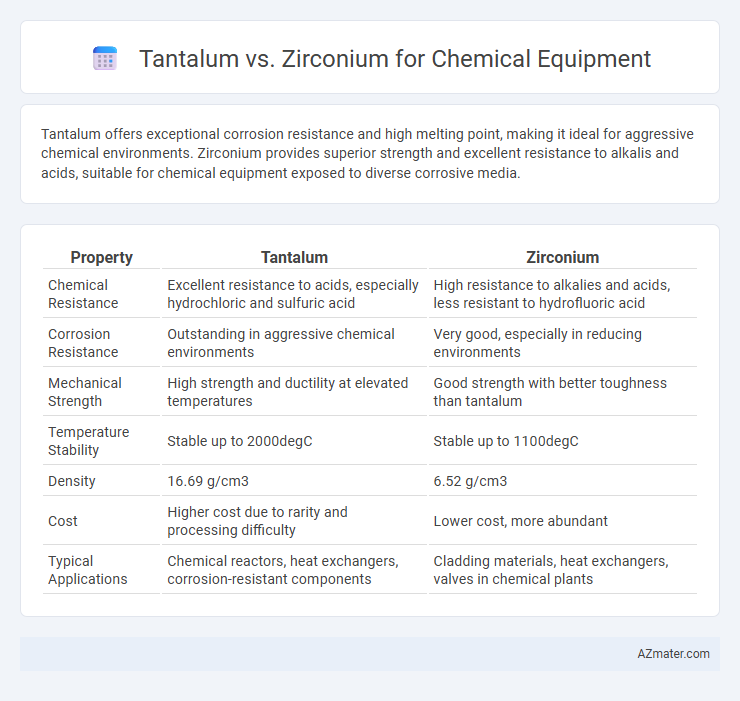Tantalum offers exceptional corrosion resistance and high melting point, making it ideal for aggressive chemical environments. Zirconium provides superior strength and excellent resistance to alkalis and acids, suitable for chemical equipment exposed to diverse corrosive media.
Table of Comparison
| Property | Tantalum | Zirconium |
|---|---|---|
| Chemical Resistance | Excellent resistance to acids, especially hydrochloric and sulfuric acid | High resistance to alkalies and acids, less resistant to hydrofluoric acid |
| Corrosion Resistance | Outstanding in aggressive chemical environments | Very good, especially in reducing environments |
| Mechanical Strength | High strength and ductility at elevated temperatures | Good strength with better toughness than tantalum |
| Temperature Stability | Stable up to 2000degC | Stable up to 1100degC |
| Density | 16.69 g/cm3 | 6.52 g/cm3 |
| Cost | Higher cost due to rarity and processing difficulty | Lower cost, more abundant |
| Typical Applications | Chemical reactors, heat exchangers, corrosion-resistant components | Cladding materials, heat exchangers, valves in chemical plants |
Introduction to Tantalum and Zirconium
Tantalum and zirconium are highly corrosion-resistant metals commonly used in chemical equipment to withstand harsh environments. Tantalum exhibits exceptional resistance to acids, especially hydrofluoric and sulfuric acid, making it ideal for lining reactors and heat exchangers. Zirconium offers outstanding strength and resistance to alkalis and chloride-induced stress corrosion cracking, frequently utilized in piping systems and storage tanks.
Chemical Properties Comparison
Tantalum exhibits exceptional corrosion resistance in highly acidic environments, including hydrochloric and sulfuric acids, making it ideal for chemical reactors handling aggressive substances. Zirconium offers superior resistance to alkalis and chloride-induced stress corrosion cracking, commonly used in nuclear and chemical processing where high-temperature stability is crucial. Both metals demonstrate high melting points and chemical inertness, but tantalum's passivation layer provides enhanced protection against oxidizing agents compared to zirconium.
Corrosion Resistance Capabilities
Tantalum exhibits exceptional corrosion resistance, especially against strong acids such as hydrochloric and sulfuric acid, making it ideal for chemical equipment exposed to highly aggressive environments. Zirconium offers superior resistance to alkaline solutions and oxidizing acids, with high stability in oxidizing and reducing media, but generally falls short of tantalum in handling hot chlorides. Selecting tantalum over zirconium enhances longevity and performance in chemical reactors, heat exchangers, and piping systems requiring robust resistance to pitting, crevice corrosion, and chemical attack.
Mechanical Strength and Durability
Tantalum exhibits exceptional mechanical strength and corrosion resistance, making it highly durable for chemical equipment exposed to aggressive environments. Zirconium offers excellent mechanical properties combined with superior resistance to stress corrosion cracking, providing reliable long-term durability in harsh chemical processes. Both metals deliver robust performance, but tantalum's higher density contributes to greater strength, while zirconium's lighter weight enhances durability under dynamic conditions.
Temperature and Pressure Tolerance
Tantalum exhibits exceptional resistance to corrosion and maintains structural integrity at high temperatures up to 300degC, making it ideal for chemical equipment subjected to moderate thermal stress. Zirconium outperforms tantalum in pressure tolerance with a higher yield strength, sustaining pressures exceeding 200 MPa in aggressive chemical environments. Both metals provide excellent chemical resistance, but zirconium's superior mechanical strength under high-pressure and high-temperature conditions makes it preferable for demanding industrial applications.
Fabrication and Welding Differences
Tantalum offers superior corrosion resistance and high melting point, requiring specialized welding techniques such as electron beam or tungsten inert gas (TIG) welding to prevent contamination and ensure joint integrity in chemical equipment fabrication. Zirconium, known for its excellent strength and corrosion resistance in aggressive environments, is typically welded using gas tungsten arc welding (GTAW) processes with careful control of shielding gas to avoid oxygen absorption and embrittlement. Fabrication of tantalum demands more precise handling due to its high density and work-hardening properties, whereas zirconium's fabrication benefits from its ductility but requires strict temperature control to maintain structural properties.
Cost Analysis and Availability
Tantalum offers exceptional corrosion resistance in aggressive chemical environments but comes at a significantly higher cost due to limited global production and complex extraction processes. Zirconium, while slightly less corrosion-resistant, is more abundant and thus more readily available, resulting in lower material and maintenance expenses for chemical equipment. Selecting between tantalum and zirconium requires balancing the high initial investment of tantalum against the cost-effectiveness and availability of zirconium for long-term chemical processing applications.
Typical Applications in Chemical Equipment
Tantalum is widely used in chemical equipment for handling highly corrosive acids such as hydrochloric acid and sulfuric acid, due to its excellent corrosion resistance and high melting point. Zirconium is favored in chemical reactors, heat exchangers, and piping systems where resistance to alkalis, chlorides, and oxidizing agents is essential, especially in nuclear and pharmaceutical industries. Both metals offer superior durability in harsh chemical environments but are selected based on specific acid and base compatibility in process applications.
Lifespan and Maintenance Needs
Tantalum offers exceptional corrosion resistance in highly acidic environments, resulting in an extended lifespan with minimal maintenance requirements, particularly in aggressive chemical processing applications. Zirconium provides strong corrosion resistance and mechanical strength but may require more frequent inspections and upkeep due to its susceptibility to stress corrosion cracking under certain conditions. Selecting tantalum for chemical equipment optimizes durability and reduces downtime, while zirconium is often preferred for cost-effectiveness when maintenance capabilities are robust.
Final Considerations: Choosing the Right Material
Tantalum offers exceptional corrosion resistance against strong acids, making it ideal for chemical equipment handling aggressive substances, while zirconium provides superior resistance to alkalis and oxidation at high temperatures. Cost-effectiveness and specific process requirements heavily influence the choice, as tantalum is more expensive but highly durable in acidic environments, whereas zirconium suits applications where thermal stability and resistance to caustic media are crucial. Evaluating chemical compatibility, mechanical properties, and thermal performance ensures selecting the right material for long-term reliability and operational efficiency in chemical processing equipment.

Infographic: Tantalum vs Zirconium for Chemical Equipment
 azmater.com
azmater.com